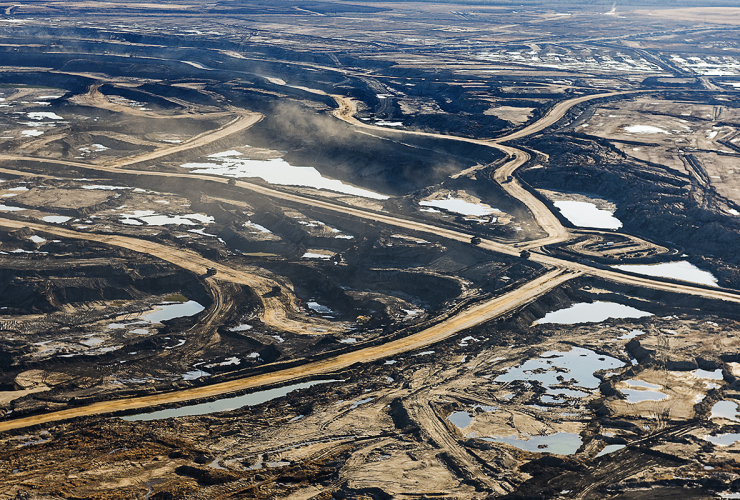Signs of the Canadian oil and gas industry’s recovery from a punishing two−year downturn are emerging in unlikely places, including fine grains of sand.
Demand for the especially round and crush−proof type of sand used to help extract shale oil and gas is climbing, as more drilling rigs get fired up and operators pump higher amounts of sand into wells, say industry watchers, who foresee a big jump in the year ahead.
"Things have really picked up," said Thomas Jacob, an analyst at research firm IHS Markit.
Canada’s energy industry was hammered when OPEC producers hiked production starting in 2014, driving oil prices to around US$26 a barrel in early 2016. But with U.S. crude back at about US$49, demand for the sand needed for hydraulic fracturing, or fracking, in shale formations is also rebounding.
Jacob expects Canadian demand to jump 70 per cent to 3.1 million tonnes this year for the specialty sand, which is pumped into the ground during a frack to keep cracked shale rocks wedged open and allow oil and gas to flow out.
Calgary−based Source Energy Services, for one, said it sold about 130,000 tonnes of the sand in January in Western Canada, up from 84,000 tonnes the same month a year earlier.
Higher demand for sand follows a sharp increase in fracking activity. In the first two months of this year, 140 wells were fracked, according to the Alberta Energy Regulator — up from 82 in the same period last year.
Momentum in the sector was enough to prompt Source in February to announce plans for a public stock listing. It said in regulatory filings that it expected this year’s appetite for sand in Canada to surpass the record high of 3.7 million tonnes in 2014. That would be a big jump from the 2.4 million tonnes it said was used last year.
Source said that if the trend of using more sand per well is factored in, demand could top six million tonnes.
Companies have been pumping more sand per well in recent years after finding it helps improve the production and reliability, said Jacob.
"The intensity is increasing across the board at a very, very high rate," he said.
Source said that between 2013 and early 2016, the Montney formation that straddles the Alberta−British Columbia border saw a 91 per cent increase in sand per well.
Gas producer Seven Generations bumped up its tonnage per well by about a third just between the end of 2015 and end of 2016 to average about 6,500 tonnes of sand per well. The change helped boost the natural−gas condensate produced by the wells by about a third, said company spokesman Alan Boras.
"It’s really about continuing to drive the costs lower on a per unit of what you can recover," said Boras.
An expected bump in sand demand didn’t stop Source from getting cold feet on its public offering. It postponed plans after oil dropped back below US$50.
Source also faces increased competition from suppliers with lower−quality sand mines that sit closer to the shale plays of northern British Columbia and Alberta.
Like the majority of Canadian suppliers, Source gets its top−tier white sand from mines in Wisconsin, the same type found in many golf course sand traps.
In the past, companies were wary of using lesser quality domestic sand, concerned that it wouldn’t stand up to the extreme pressures several kilometres underground.
That changed in the downturn as companies looked to cut costs everywhere, and started finding the cheaper sand was effective.
"We definitely see some blue−chip companies pumping the domestic product, because they’re not seeing production benefits by pumping import or tier one products," said Mike Burvill, vice−president of fracturing at Calgary−based STEP Energy Services.
Burvill estimates that about a third of the sand STEP pumps for clients is domestic brown sand, compared with 10 per cent before the downturn.
Encana chief operating officer Mike McAllister said on a conference call last year that the company had created long−term structural savings because it was using the cheaper local brown sands.
"The largest cost driver in our completion costs are water and sand," said McAllister. "In the Duvernay (formation) on a per−well basis, we are saving over $130,000 per well as a result of using that sand."
The article doesn't say where
The article doesn't say where the brown sand is sourced from. Does it come from a mine also, or is it dredged from bodies of water? Dredging destroys aquatic beds and the huge pipes suck up all species in the vicinity along with the sand. It is all crushed up together and removed, leaving an aquatic wasteland behind that no longer supports vegetation, which means not much can survive there in future. Sand bars protect ocean beds and delicate ecosystems like coral reefs, from damage by big storms. They act as a breakwater to protect land masses from big storm waves. Even beach sand is being stolen in some countries and illegal dredging has led to political spats between some countries in South Asia. The documentary Sand Wars gives an excellent, albeit frightening, glimpse into what is an unrecognized crisis. It is the same old story - sand is FREE so it has become a gold rush of exploitation. Alternatives can be used, but companies refuse to pay, governments are complicit, and the public has no idea what is happening.





Comments